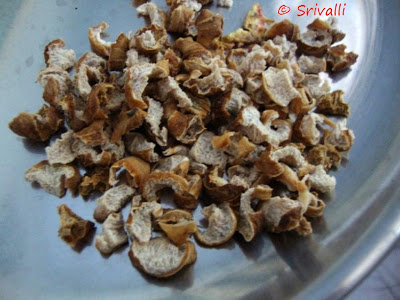This is yet another wonder powder that we can make from what we have at home for Diabetes care. I have listed below some details on each of these three fruits that I have used, sourced from internet. I am not able to cite specific site for contributing these details, but in general the information is retrieved from researching on many sites available online. I would like to thank the individual authors for their contribution.
Pomegranate
Apart from being healthy, pomegranate is delicious too. Pomegranate consists of antioxidant, antiviral and anti-tumour properties. It is said to be a good source of vitamins as it includes vitamin A, C and E as well as folic acid. This fruit consists of three times the antioxidants of wine or green tea. It is said to be the powerhouse of health. Pomegranates are known mostly for curing the problems related to heart and for maintaining effective and healthy blood circulation. Other health benefits include cure of stomach disorders, cancer, dental care, osteoarthritis, anemia and diabetes.
Indian Gooseberry
In general Indian Gooseberry is considered very healthy due to its high vitamin C content. Amla enhances food absorption, balances stomach acid, fortifies the liver, nourishes the brain and mental functioning, supports the heart, strengthens the lungs, regulates elimination, enhances fertility, helps the urinary system, is good for the skin, promotes healthier hair, acts as a body coolant, flushes out toxins, increases vitality, strengthens the eyes, improves muscle tone and it acts as an antioxidant.
The health benefits of amla include the following:
- Eye care: Taking Gooseberry juice with honey is good for improving eyesight. It improves nearsightedness and cataract. It reduces interocular tension.
- Diabetes: Gooseberry contains chromium. It has a therapeutic value in diabetics. Indian Gooseberry or Amla stimulate the isolated group of cells that secrete the hormone insulin. Thus, it reduces blood sugar in diabetic patient.
- Heart disease: Gooseberry strengthens heart muscles. So heart pumps blood flawless throughout the body.
- Infection: Due to its antibacterial and astringent attributes the Indian Gooseberry protects against infection. It improves body resistance.
- Hair loss: Amla is used in many hair tonics. It enriches hair growth and hair pigmentation. It strengthens roots of hair , maintains color and luster. Eating fresh fruit or applying its paste on hair roots improves hair growth and color.
- Improving appetite: Consuming Gooseberry powder with butter and honey before meal improves appetite. It helps in balancing Nitrogen level and thus increases weight in a healthy way.

Fenugreek
Due to its estrogen-like properties, fenugreek has been found to help increase libido and lessen the effect of hot flashes and mood fluctuations that are common symptoms of menopause and PMS. In India and China it has also been used to treat arthritis, asthma, bronchitis, improve digestion, maintain a healthy metabolism, increase libido and male potency, cure skin problems (wounds, rashes and boils), treat sore throat, and cure acid reflux. Fenugreek also has a long history of use for the treatment of reproductive disorders, to induce labor, to treat hormonal disorders, to help with breast enlargement, and to reduce menstrual pain. Recent studies have shown that Fenugreek helps lower blood glucose and cholesterol levels, and may be an effective treatment for both type 1 and 2 diabetes. Fenugreek is also being studied for its cardiovascular benefits.
What you see above is the final ball that is done by drying these skin of Pomegranate, pitted Indian gooseberry and dried fenugreek. All these are sun dried for a day or till they are really dry and powder to a fine powder.

Once a day, the diabetic patient can mix all three powders with little water and consume.
Earlier on Diabetes:
General Notes on Diabetes
Introduction to Diabetes ~ What Is Diabetes?
Why Early Diagnosis Is Important?
Diagnosing Diabetes ~ Different Types Of Diabetes
Dietary aspects in the management of diabetes
Dietary aspects in the management of diabetes ~ Glycemic Index!
Glycemic Index of different foods
Diabetes Diet:
Appey or Paniyaram with Jowar Four
Healthly Snack with Chickpea Salad
Gooseberry Rice
Guava ~ the Wonder Fruit
Jamun Seed Powder ~ Diet for Diabetics!
Stuffed Paratha with Greens




jayasree says
Very informative post. I knew about fenugreek for diabetics. It will be useful for my Mom.
Aruna Manikandan says
Love your information ..
Will definitely prepare this powder
Love to share an award with u . Kindly accept it
A 2 Z Vegetarian Cuisine says
Srivalli, this is a great post!!!
Didan says
Excellent post. Ironically, today I stumbled upon your blog through google looking for a tamarind rice recipe.. but I was surprised to see this post as I had learned about fenugreek's anti-diabetic properties earlier today!! I had never heard of this fact before.
pelicano says
After these are powdered, do we mix equal parts together? I would like to prepare this for my cousin. Great post!
Srivalli says
Thank you everybody,
Pel, yes you can take it in equal portions